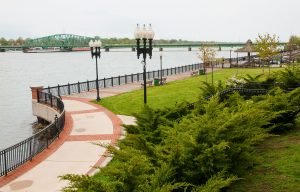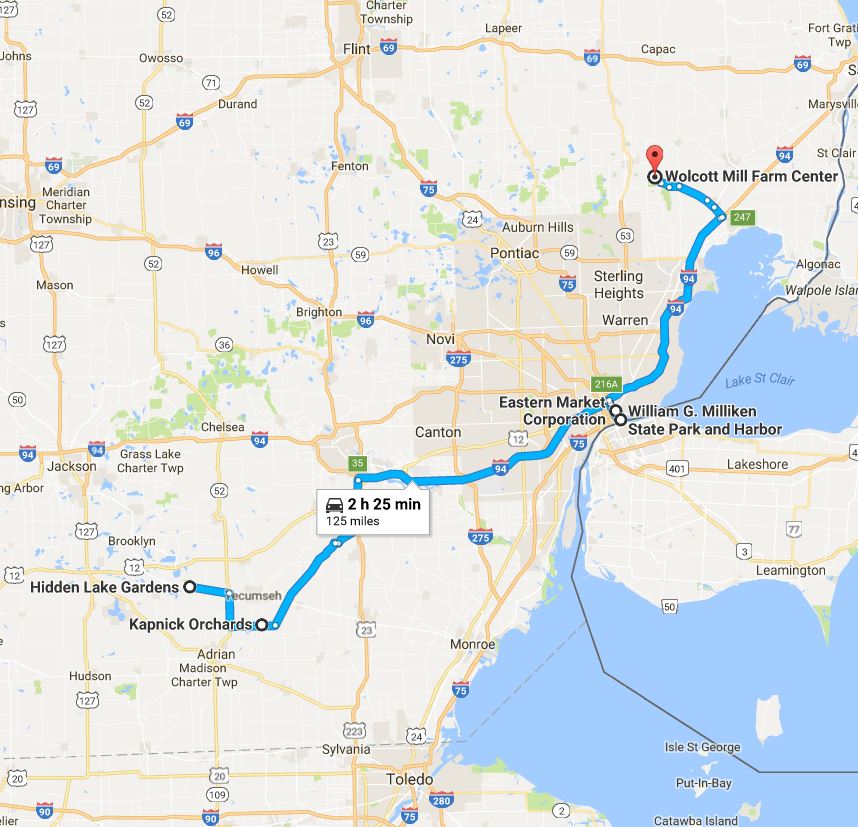The southeast region of Michigan is most known for its cities and factories. Detroit, Ann Arbor, Lansing, and all of their associated suburbs are full of hustle and bustle, congested streets, and art and culture.
But in this fine state, the outdoors still beckons – and city architects have made sure that there is plenty of opportunity to reconnect with nature even in the midst of gray concrete and black asphalt. Visit these places over the course of two or three days to really immerse yourself in the experience of each location. Just because you’re in and around cities doesn’t mean you need to go at a city pace.
Length of Tour: 2 hours, 26 minutes
This may vary with traffic and construction.
(You can use the Waze app – described in this article “9 Smart Apps for RVers with Smartphones” – to help you navigate and plan ahead for traffic, plus find alternate routes.)
Total Miles: 125 Miles
Stop #1: Hidden Lake Gardens, Tipton
Owned and maintained by Michigan State University, Hidden Lake Gardens is open 9am – 7pm. It’s truly an enchanted place, full of life and color and variety. You can take a leisurely drive and see many of the garden highlights from your vehicle; however, it’s best to park and get out on foot for a more personal look. You can take an easy hike to and around Hidden Lake, or relax in the tranquil peace of the Great Meadow. And definitely don’t overlook the glass ceiling conservatory. Guided tours are available, but it’s best to arrange this at least two weeks before your intended visit. Here’s what you can expect to see at Hidden Gardens (Map). Check the website, too, to see what’s in bloom, which is updated on a weekly basis.
Insider tip: The first Monday of every month is free, so time your visit to avoid paying the $3.00 per person entrance fee.
Stop #2: Kapnick Orchards, Britton
This family owned business has it all: a picturesque orchard, u-pick fruits, a bakery, a cider mill, and homemade baked goods, fudge, and fruit spreads. Stop in this old-fashioned establishment to pick up some bread (and maybe fresh donuts!) and seasonal fruit. Depending on when you go to Kapnick Orchards, you may be able to pick sweet cherries, blueberries, pumpkins, peaches, apples, or tart cherries. There’s nothing better than fruit fresh from right off the tree or to have around as a treat at the campsite.
Insider tip: Take home some apple butter, made fresh every fall with apples from the farm, cider, and an old family recipe. There is no sugar or artificial sweeteners either.
Stop #3: Eastern Market, Downtown Detroit
Okay, so this isn’t necessarily “nature,” but rather nature’s bounty. You can’t be around Detroit without stopping at the historic Eastern Market. You can find seasonal produce, baked goods, fresh meat, flowers, and lots more! Do all your shopping for your campsite here if you can as the selection is expansive and the prices are low. It’s an experience in and of itself, and it’s so large, you’ll need at least a few hours to explore the food vendors, flower vendors, and artisans. Eastern Market is used for tailgating for Detroit Lions games, so there is definitely space for the RV. The traditional market day is Saturday, but there are other markets on different days of the week. Check the website for more details and market hours.
Insider tip: As the old saying goes, the early bird gets the worm, so make sure to get there early enough in the morning so that you get the best selection as well as the best parking spot.

Michigan park along the Detroit river.
Stop #4: William G. Milliken State Park and Harbor, Downtown Detroit
Stretch your legs with a 30-minute walk to the state’s first urban park that sits beside the Detroit River. You can also drive about 10 minutes, though parking could be a challenge. The 31-acre park is described as a “green oasis” and includes covered picnic areas, shoreline fishing, and a large harbor. There is also a light tower that you can visit, a replica of the Victorian-era Tawas Point Lighthouse, at the harbor entrance. Visit the wetlands demonstration area if you wish, and take a stroll along part of the Detroit RiverWalk to view the river and enjoy the well-tended and colorful landscaping. The tall city buildings still loom behind or beside you, but you’ll be able to get some breathing room and tend to forget that you’re in a large American city.
Insider tip: Sit back and relax. Find a bench and watch the passing ships. But make sure to wear sunscreen!
Stop #5: Wolcott Mill Farm Center, Ray
Just up 94, about 50 minutes north of downtown Detroit, is Wolcott Mill Farm Center, part of the Huron-Clinton Metroparks network. You will need to get a vehicle entry permit for your visit. Stop in at this 250-acre working farm to learn about farm life, visit the animals, and explore the gardens and greenhouse. Visit with cows, sheep, goats, draft horses, and fowl. You can even take a horse-drawn wagon ride through the crop fields. If you have kids, this is a place you don’t want to miss. Check out their online calendar for special events for the farm center. You can also explore the rest of Wolcott Mill, including a historic center with grist and feed mill as well as a barn museum. Explore the nature trails if you have time!
Insider tip: Take the camera along to capture exquisite nature scenes, or a fishing pole to fish for bluegills at the farm pond (license required).
If you’re driving a truck camper or Class B motorhome, you should be able to park with relative ease, even parking garages (though always check the height restrictions). If you have a large trailer or Class A motorhome, it’s better to take your tow vehicle or toad if you have one instead. Not only will this help with parking, you’ll have better visibility and less to worry about as you drive on crowded highways and tight city streets. Find more RV safety tips to use while you’re en route in “RV Safety During Travel and Around the Campground.”

